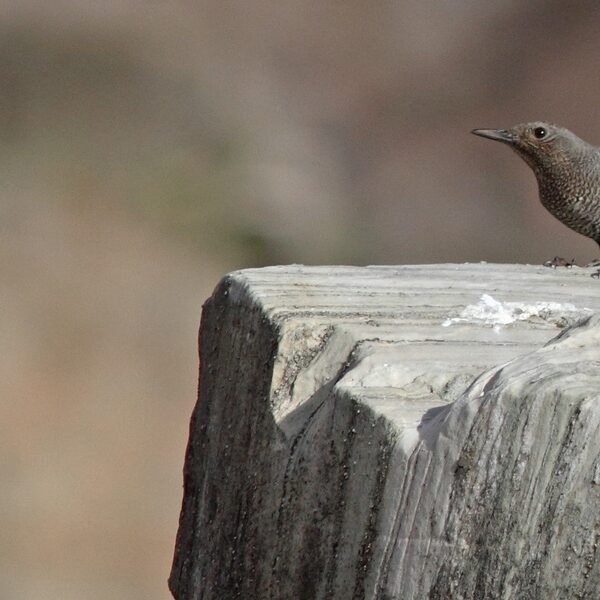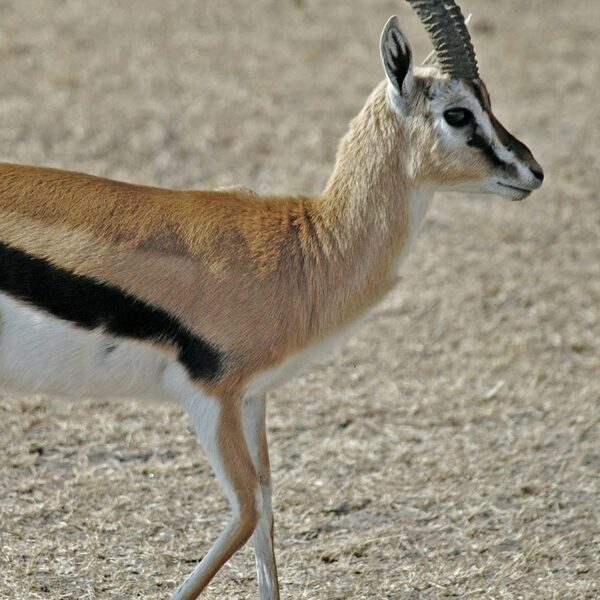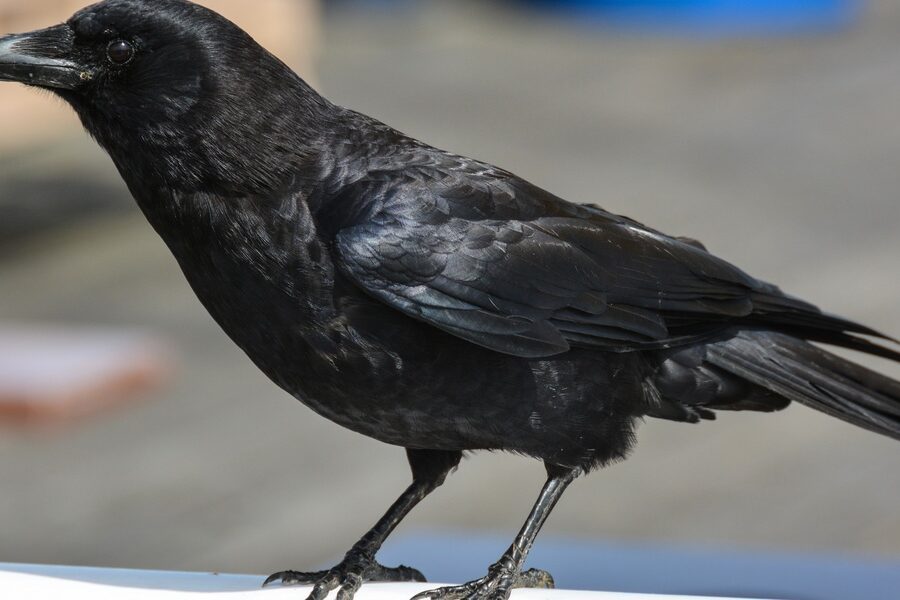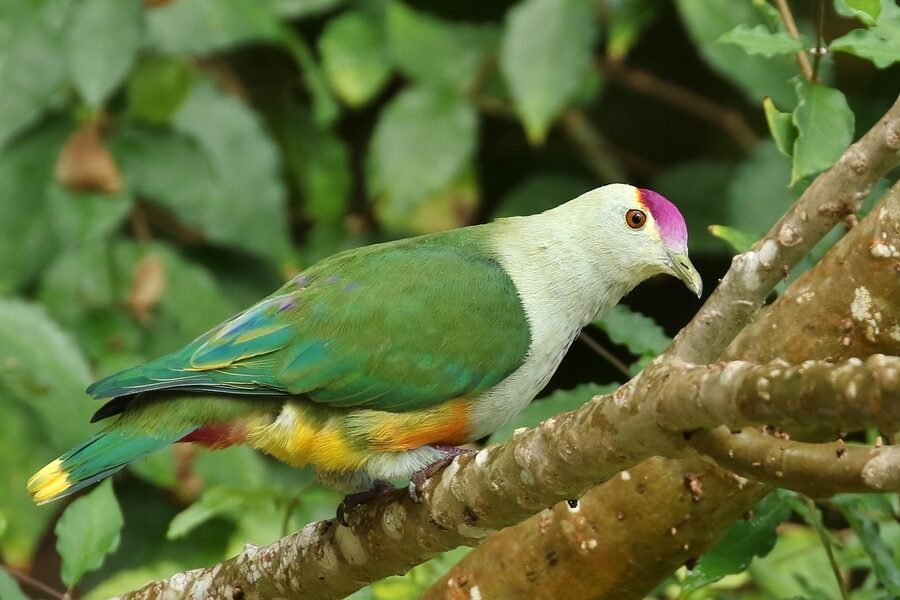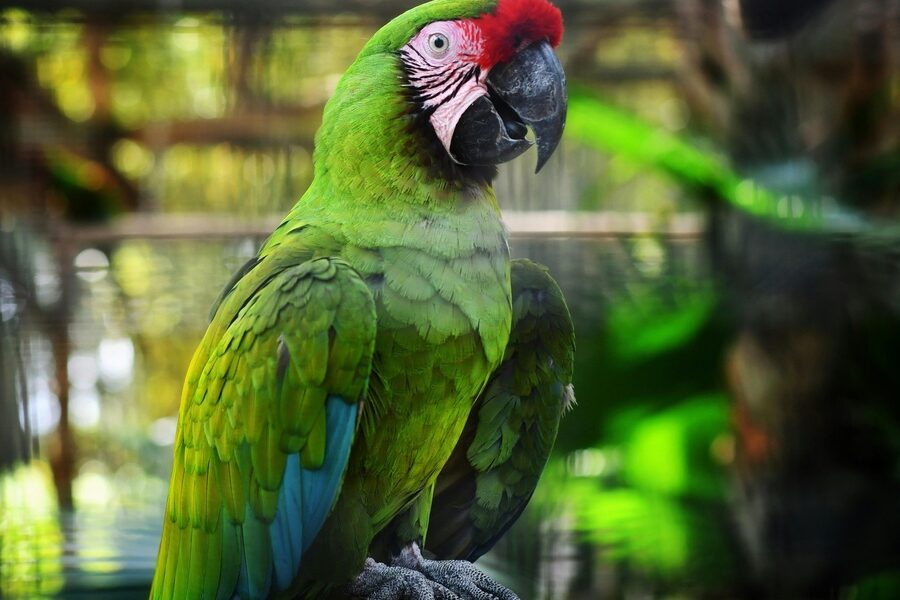Namibia’s varied landscapes — from the Skeleton Coast and coastal wetlands to inland savannas and dry scrub — support a wide and interesting set of bird species. Whether you’re scanning tidal flats for waders or listening for calls in acacia woodlands, the country rewards attention with both common and unexpected sightings.
There are 93 Birds of Namibia, ranging from Acacia Pied Barbet to Yellow-billed Stork. The list is organized with Scientific name,Size (cm),Status & hotspots — you’ll find below.
When is the best time to birdwatch in Namibia?
The prime months are generally late spring to early autumn (September–April) when migrants arrive and many species are more active; coastal sites can be good year-round but inland hotspots are best after rains when food and water attract concentrations of birds.
How can I use this list to plan a birding trip?
Use the Scientific name to confirm identification, the Size (cm) to set expectations in the field, and the Status & hotspots to target likely locations and seasonal chances; combine a few nearby hotspots per day to maximize species observed.
Birds of Namibia
| Common name | Scientific name | Size (cm) | Status & hotspots |
|---|---|---|---|
| Common Ostrich | Struthio camelus | 250 | Common resident in arid savanna and desert plains. Etosha, Namib-Naukluft, Kalahari. |
| African Penguin | Spheniscus demersus | 65 | Rare vagrant on the coast, breeding colonies are further south. Sightings near Lüderitz. |
| Great Crested Grebe | Podiceps cristatus | 48 | Uncommon resident on large, open freshwater bodies. Hardap and Von Bach Dams. |
| Black-necked Grebe | Podiceps nigricollis | 30 | Common non-breeding migrant. Abundant at Walvis Bay and coastal salt works. |
| Little Grebe | Tachybaptus ruficollis | 27 | Common resident on most freshwater bodies. Widespread, including farm dams and ponds. |
| Shy Albatross | Thalassarche cauta | 95 | Regular pelagic visitor to offshore waters, especially in winter. Seen on pelagic trips. |
| White-chinned Petrel | Procellaria aequinoctialis | 55 | Common pelagic visitor, often seen from shore during storms. Coastal waters. |
| Cape Gannet | Morus capensis | 90 | Common coastal resident, breeding on offshore islands. Mercury and Ichaboe Islands. |
| Cape Cormorant | Phalacrocorax capensis | 62 | Abundant coastal resident, forms huge flocks. Walvis Bay, Lüderitz, offshore islands. |
| Bank Cormorant | Phalacrocorax neglectus | 75 | Endangered and endemic resident to southern Africa’s coast. Mercury and Ichaboe Islands. |
| Crowned Cormorant | Microcarbo coronatus | 54 | Uncommon coastal resident, preferring sheltered bays and lagoons. Walvis Bay, Lüderitz. |
| Reed Cormorant | Microcarbo africanus | 55 | Common resident on inland wetlands and slow-moving rivers. Caprivi Strip, Okavango River. |
| White-breasted Cormorant | Phalacrocorax lucidus | 90 | Common resident on both coastal and large inland waters. Widespread. |
| African Darter | Anhinga rufa | 80 | Uncommon resident of freshwater wetlands with clear water. Okavango and Kwando rivers. |
| Great White Pelican | Pelecanus onocrotalus | 160 | Common coastal resident and inland visitor. Walvis Bay, Etosha Pan (breeding). |
| Pink-backed Pelican | Pelecanus rufescens | 130 | Uncommon resident of large wetlands in the north. Caprivi Strip, Mahango NP. |
| Goliath Heron | Ardea goliath | 140 | Uncommon resident of major northern wetlands. Okavango, Kwando, and Zambezi rivers. |
| Grey Heron | Ardea cinerea | 95 | Common resident near water bodies throughout the country. Widespread. |
| Black-headed Heron | Ardea melanocephala | 92 | Common resident in grassland, savanna, and wetlands. Widespread, often away from water. |
| Cattle Egret | Bubulcus ibis | 54 | Very common resident, often associated with livestock. Widespread. |
| Little Egret | Egretta garzetta | 60 | Common resident near coastal and inland wetlands. Widespread. |
| Hamerkop | Scopus umbretta | 56 | Common resident near water, especially dams and slow rivers. Widespread. |
| Saddle-billed Stork | Ephippiorhynchus senegalensis | 145 | Uncommon resident of northern wetlands. Mahango NP, Caprivi Strip. |
| Marabou Stork | Leptoptilos crumeniferus | 150 | Common resident and visitor, often at carcasses and refuse dumps. Etosha NP. |
| Yellow-billed Stork | Mycteria ibis | 97 | Common resident in northern wetlands. Okavango River, Mahango NP, Caprivi. |
| African Openbill | Anastomus lamelligerus | 85 | Locally common resident in northern wetlands. Chobe and Zambezi rivers. |
| Black Stork | Ciconia nigra | 97 | Uncommon breeding resident in arid, rocky areas. Fish River Canyon, Naukluft. |
| White Stork | Ciconia ciconia | 110 | Common Palearctic non-breeding migrant (summer visitor). Widespread in open habitats. |
| Hadeda Ibis | Bostrychia hagedash | 76 | Common resident in woodlands and gardens, expanding its range. Caprivi, central areas. |
| African Sacred Ibis | Threskiornis aethiopicus | 75 | Common resident in wetlands and grasslands. Widespread. |
| Glossy Ibis | Plegadis falcinellus | 60 | Locally common nomad, found in wetlands. Etosha NP, Caprivi Strip. |
| African Spoonbill | Platalea alba | 90 | Common resident of inland and coastal wetlands. Widespread. |
| Greater Flamingo | Phoenicopterus roseus | 145 | Common coastal resident and inland nomad. Walvis Bay, Sandwich Harbour, Etosha Pan. |
| Lesser Flamingo | Phoeniconaias minor | 90 | Abundant coastal resident and inland nomad. Walvis Bay, Lüderitz. |
| Egyptian Goose | Alopochen aegyptiaca | 68 | Very common resident near any water body. Widespread. |
| Spur-winged Goose | Plectropterus gambensis | 88 | Common resident in northern wetlands. Caprivi Strip, Mahango NP. |
| Cape Teal | Anas capensis | 46 | Common resident on coastal and inland saline wetlands. Walvis Bay, Etosha NP. |
| Red-billed Teal | Anas erythrorhyncha | 46 | Common resident on freshwater wetlands. Widespread, especially Etosha NP. |
| Secretarybird | Sagittarius serpentarius | 135 | Uncommon resident of open savanna and grassland. Etosha NP, Kalahari. |
| African Fish Eagle | Haliaeetus vocifer | 70 | Common resident near large rivers and dams. Okavango, Kunene, and Chobe rivers. |
| Bateleur | Terathopius ecaudatus | 65 | Uncommon resident of savanna and woodland. Etosha NP, Caprivi Strip. |
| Lappet-faced Vulture | Torgos tracheliotos | 105 | Uncommon resident of arid savanna. Namib-Naukluft Park, Etosha NP. |
| White-backed Vulture | Gyps africanus | 90 | Common but declining resident of savanna. Etosha NP, Caprivi Strip. |
| Martial Eagle | Polemaetus bellicosus | 86 | Uncommon resident of open savanna and woodland. Widespread but sparsely distributed. |
| Tawny Eagle | Aquila rapax | 72 | Common resident in savanna and open woodland. Widespread, especially Etosha NP. |
| Black-chested Snake Eagle | Circaetus pectoralis | 65 | Common resident of open savanna and semi-desert. Widespread. |
| Jackal Buzzard | Buteo rufofuscus | 50 | Common resident in mountainous and hilly terrain. Escarpment, central highlands. |
| African Harrier-Hawk | Polyboroides typus | 63 | Common resident in woodland and savanna, often near cliffs. Widespread. |
| Osprey | Pandion haliaetus | 60 | Uncommon migrant, mainly found along the coast and northern rivers. Coastal wetlands, major rivers. |
| Black-shouldered Kite | Elanus caeruleus | 30 | Common resident of open grassland and savanna. Widespread. |
| Peregrine Falcon | Falco peregrinus | 45 | Uncommon resident and migrant, often near cliffs or water. Widespread but sparse. |
| Lanner Falcon | Falco biarmicus | 45 | Common resident in arid savanna and mountainous areas. Widespread. |
| Rock Kestrel | Falco rupicolus | 32 | Common resident in rocky, mountainous areas and even towns. Widespread. |
| Pygmy Falcon | Polihierax semitorquatus | 20 | Common resident in arid savanna with Sociable Weaver nests. Kalahari, Etosha. |
| Helmeted Guineafowl | Numida meleagris | 56 | Common resident in savanna, woodland, and agricultural lands. Widespread. |
| Hartlaub’s Spurfowl | Pternistis hartlaubi | 28 | Near-endemic resident of rocky hills and escarpments. Erongo, Waterberg. |
| Red-billed Spurfowl | Pternistis adspersus | 36 | Common resident of dry savanna and thornveld. Widespread in the north and centre. |
| Kori Bustard | Ardeotis kori | 120 | Uncommon resident of open grasslands and savanna. Etosha NP, Kalahari. |
| Ludwig’s Bustard | Neotis ludwigii | 85 | Near-endemic nomad of arid plains and semi-desert. Namib-Naukluft Park. |
| Rüppell’s Korhaan | Eupodotis rueppellii | 60 | Near-endemic resident of gravel plains in the Namib Desert. Namib-Naukluft Park. |
| Grey Crowned Crane | Balearica regulorum | 105 | Uncommon resident of northern floodplains and marshes. Caprivi Strip. |
| Blue Crane | Anthropoides paradiseus | 115 | Rare localised resident, mainly around Etosha Pan. Etosha NP. |
| Red-knobbed Coot | Fulica cristata | 40 | Common resident on freshwater bodies with vegetation. Widespread. |
| African Oystercatcher | Haematopus moquini | 44 | Uncommon coastal resident, preferring rocky and sandy shores. Lüderitz, Walvis Bay. |
| Black-winged Stilt | Himantopus himantopus | 37 | Common resident of coastal and inland wetlands. Widespread. |
| Pied Avocet | Recurvirostra avosetta | 44 | Common resident and migrant on coastal and inland wetlands. Walvis Bay, Etosha. |
| Crowned Lapwing | Vanellus coronatus | 30 | Common resident of dry, open grasslands and savanna. Widespread. |
| Kittlitz’s Plover | Charadrius pecuarius | 16 | Common resident of open pans, estuaries, and short grasslands. Etosha NP, Walvis Bay. |
| Chestnut-banded Plover | Charadrius pallidus | 15 | Near-threatened resident of coastal and inland salt pans. Walvis Bay, Sandwich Harbour. |
| Damara Tern | Sternula balaenarum | 23 | Near-endemic summer breeding migrant. Breeds on coastal gravel plains. |
| Kelp Gull | Larus dominicanus | 60 | Abundant coastal resident. Entire coastline. |
| Hartlaub’s Gull | Chroicocephalus hartlaubii | 38 | Common coastal resident, endemic to southern Africa. Walvis Bay, Swakopmund, Lüderitz. |
| Namaqua Sandgrouse | Pterocles namaqua | 28 | Common nomad of arid plains and semi-desert. Widespread in arid zones. |
| Speckled Pigeon | Columba guinea | 33 | Common resident in rocky areas and towns. Widespread. |
| Cape Turtle Dove | Streptopelia capicola | 26 | Abundant resident in almost all habitats except true desert. Widespread. |
| Laughing Dove | Spilopelia senegalensis | 25 | Common resident in savanna, woodland, and urban areas. Widespread. |
| Namaqua Dove | Oena capensis | 26 | Common nomad in arid savanna and semi-desert. Widespread. |
| Rosy-faced Lovebird | Agapornis roseicollis | 17 | Near-endemic and common resident of arid savanna. Widespread in central/western areas. |
| Rüppell’s Parrot | Poicephalus rueppellii | 23 | Near-endemic resident of dry savanna with large trees. North-western Namibia. |
| Grey Go-away-bird | Corythaixoides concolor | 50 | Common resident of savanna and woodland. Widespread in the north and centre. |
| Spotted Eagle-Owl | Bubo africanus | 45 | Common resident in a variety of habitats, including urban areas. Widespread. |
| Barn Owl | Tyto alba | 36 | Common resident, often found near human settlements. Widespread. |
| Pearl-spotted Owlet | Glaucidium perlatum | 19 | Common resident of savanna and woodland. Widespread in north and central regions. |
| Red-faced Mousebird | Urocolius indicus | 32 | Common resident in savanna, gardens, and woodland edge. Widespread. |
| Pied Kingfisher | Ceryle rudis | 25 | Common resident near fresh and salt water. Widespread. |
| Malachite Kingfisher | Corythornis cristatus | 13 | Common resident of freshwater bodies with reedy vegetation. Northern rivers, central dams. |
| Lilac-breasted Roller | Coracias caudatus | 36 | Common resident of open savanna and woodland. Etosha NP, Caprivi Strip. |
| African Hoopoe | Upupa africana | 28 | Common resident in savanna, woodland, and gardens. Widespread. |
| Southern Yellow-billed Hornbill | Tockus leucomelas | 50 | Common resident of dry savanna and woodland. Widespread in north and central regions. |
| Monteiro’s Hornbill | Tockus monteiri | 56 | Near-endemic resident of arid, rocky savanna. North-western escarpment. |
| Damara Hornbill | Tockus damarensis | 50 | Endemic subspecies, sometimes treated as full species. North-central Namibia. |
| Acacia Pied Barbet | Tricholaema leucomelas | 18 | Common resident of arid savanna and thornveld. Widespread. |
| Sociable Weaver | Philetairus socius | 14 | Common resident of arid savanna in the southern half. Kalahari, south of Etosha. |
Images and Descriptions
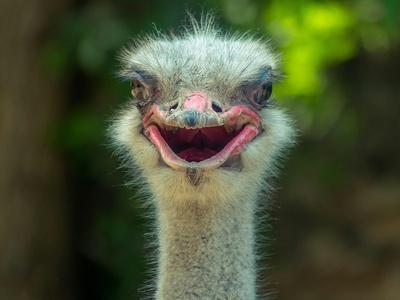
Common Ostrich
The world’s largest bird, the flightless ostrich is an icon of the African savanna. Males are bold black and white, while females are a dusty brown. They use powerful legs to outrun predators and can deliver a formidable kick if cornered.
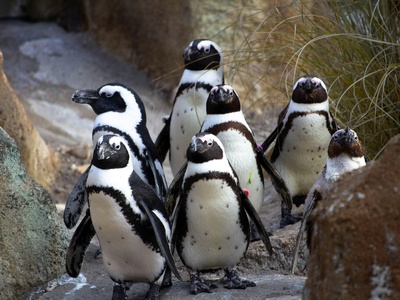
African Penguin
This charismatic, endangered seabird is uniquely adapted to Africa’s southern coast. Its distinctive braying call gives it the nickname “jackass penguin.” It is a superb swimmer, hunting for small fish like sardines and anchovies in the cold Benguela current.
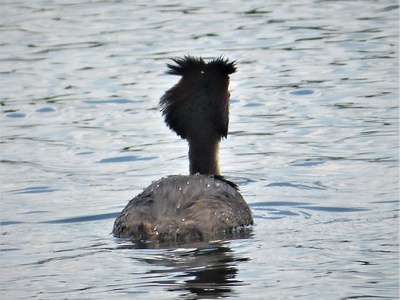
Great Crested Grebe
An elegant waterbird with a slender neck and ornate head plumes during breeding season. Famous for its elaborate and synchronized courtship dance, where pairs offer each other water weeds. Dives with expertise to catch fish, its primary food source.

Black-necked Grebe
A small, delicate grebe that forms huge flocks on coastal lagoons in winter. In breeding plumage, it is stunning, with golden ear-tufts and a bright red eye. It feeds on brine shrimp and aquatic insects, often diving in unison with others.
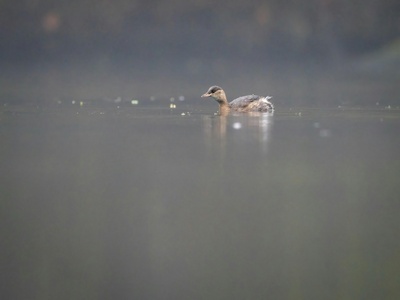
Little Grebe
A tiny, buoyant waterbird also known as a dabchick. It often appears and disappears with a sudden dive. In breeding season, it has a rich chestnut throat and a distinctive pale yellow spot at the base of its bill, and a trilling call.

Shy Albatross
A large, graceful seabird with an enormous wingspan, allowing it to glide effortlessly over the ocean. It has a mostly white head, grey back, and dark wingtips. It scavenges for squid and fish, often following fishing trawlers for an easy meal.
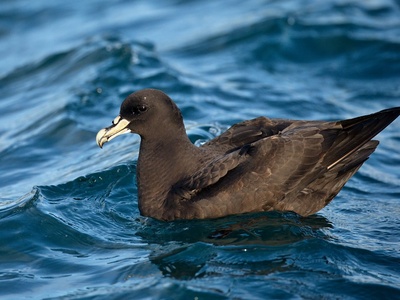
White-chinned Petrel
A large, sooty-black petrel with a contrasting pale, horn-coloured bill and a variable white patch on its chin. It is a bold and powerful flier, often seen scavenging from fishing vessels or snatching prey from the ocean surface.
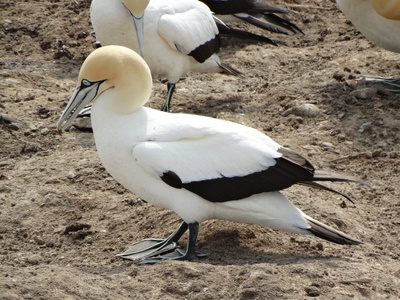
Cape Gannet
A large, striking seabird with brilliant white plumage, a yellow-gold head, and black wingtips. They are spectacular plunge-divers, plummeting from great heights into the sea at high speed to catch fish like sardines and anchovies near the surface.
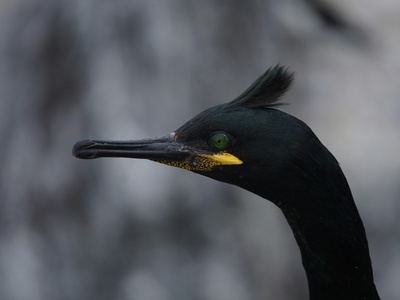
Cape Cormorant
A sleek, entirely black seabird with a turquoise eye and a small orange-yellow gular patch. Often seen in massive, V-shaped flocks flying low over the water. They are social birds, nesting in dense colonies on offshore islands and feeding cooperatively.

Bank Cormorant
A large, heavy-bodied cormorant with entirely black plumage and a prominent crest during breeding season. It is a marine specialist, feeding on bottom-dwelling fish near kelp beds. Its population is in steep decline, making it a key conservation concern.
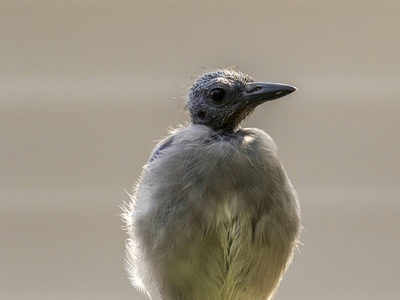
Crowned Cormorant
A small, slender cormorant with a distinctive red eye and a prominent spiky crest in the breeding season. Less social than other cormorants, it is often seen perched on buoys or jetties, holding its wings out to dry after diving for fish.

Reed Cormorant
A small, glossy-black cormorant with a long tail, common on freshwater systems across Namibia. It has a reddish eye and a small yellow gape. Unlike its marine cousins, it prefers the calmer waters of rivers, dams, and marshes for hunting fish.

White-breasted Cormorant
A large, familiar cormorant easily identified by its clean white throat and breast contrasting with its black body. It can be found almost anywhere with water, from coastal lagoons to inland dams, where it dives for a wide variety of fish.
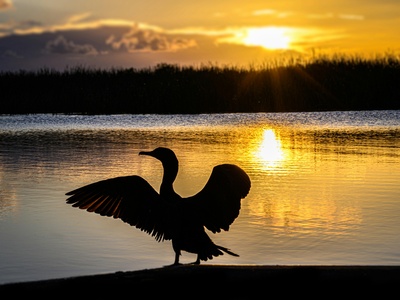
African Darter
Often called the “snakebird” for its habit of swimming with only its long, slender neck above water. After diving, it perches with wings outstretched to dry. It uses its sharp, dagger-like bill to spear fish before flicking them into the air to swallow.
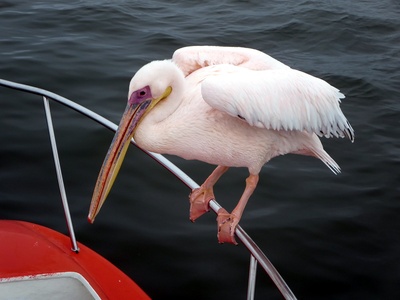
Great White Pelican
A huge, unmistakable waterbird with brilliant white plumage and a massive yellow-orange throat pouch. They are social birds, often fishing cooperatively by forming a line to drive fish into shallow water. Their synchronised take-off is a spectacular sight.
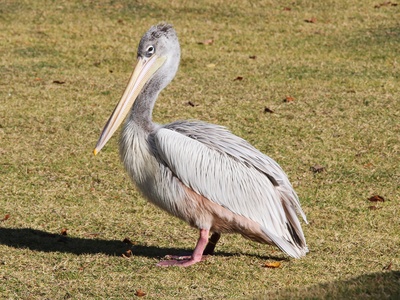
Pink-backed Pelican
Slightly smaller than its white cousin, this pelican has greyish-white plumage that shows a pinkish hue on its back. It prefers freshwater habitats and often nests in trees. It is less social when feeding, typically hunting alone or in small groups.
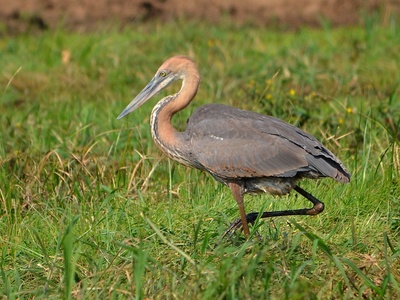
Goliath Heron
The world’s largest heron, a truly magnificent and imposing bird. It has a chestnut head and neck with a slate-grey body. A solitary and patient hunter, it stands motionless in shallow water for long periods, waiting to strike large fish with its powerful bill.
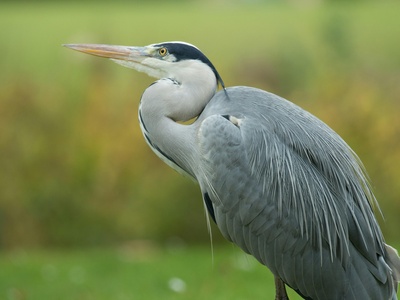
Grey Heron
A large, elegant heron with long legs, a grey back, and white underparts. Its S-shaped neck and dagger-like bill are characteristic. It is a patient predator, stalking fish, frogs, and insects in shallow water or waiting motionless for prey to approach.
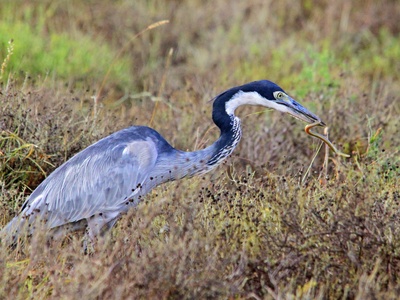
Black-headed Heron
Similar in size to the Grey Heron but with a contrasting black head and neck. Unlike most herons, it often forages in dry grasslands and fields, hunting for rodents, insects, and reptiles, making it a common sight in agricultural areas.
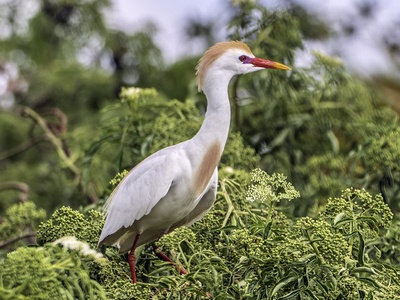
Cattle Egret
A small, stocky white egret famous for following cattle, game, and even tractors to catch insects disturbed by their movement. During breeding season, it develops beautiful buff-orange plumes on its head, chest, and back. Highly social and often roosts in large numbers.

Little Egret
An elegant, all-white egret with black legs and distinctive bright yellow feet, which it sometimes uses to stir up prey in the water. It is an active hunter, often seen dashing through the shallows to catch small fish and amphibians.

Hamerkop
A unique, medium-sized bird with drab brown plumage, a stout bill, and a shaggy crest that gives its head a hammer-like shape. Famous for building enormous, sturdy, dome-shaped nests from sticks, mud, and grass, often in the fork of a tree.

Saddle-billed Stork
A spectacular, very tall stork with striking black-and-white plumage and a massive, brightly coloured bill. The bill is red with a black band and a yellow “saddle” at the top. They are typically seen in pairs, striding majestically through shallow wetlands.
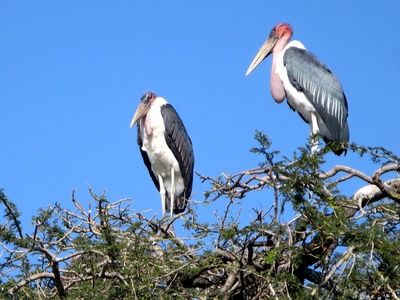
Marabou Stork
A huge, peculiar-looking stork often called the “undertaker bird” due to its hunched posture, bare head, and massive bill. It is a highly effective scavenger but will also hunt live prey like fish, frogs, and even other birds.
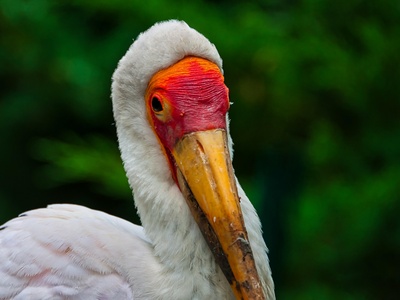
Yellow-billed Stork
A medium-sized, mainly white stork with a bright yellow, slightly decurved bill and pinkish-red facial skin. It is a highly specialised feeder, wading through shallow water with its bill partially open, snapping it shut the instant it touches a fish.

African Openbill
A medium-sized, all-black stork with a unique bill that has a distinct gap between the mandibles. This specialised bill is perfectly adapted for extracting snails, its primary food source, from their shells. Often seen foraging in marshy areas.
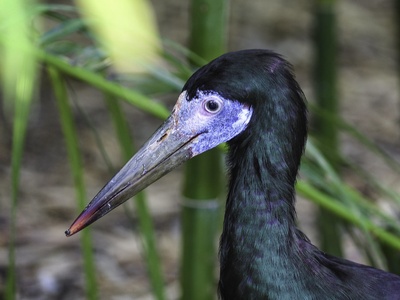
Black Stork
A shy and solitary stork with glossy black plumage and a white belly. Unlike most storks, it nests on cliffs and rocky outcrops, often in remote canyons. It forages in shallow rivers for fish and amphibians, making it a rare and special sighting.
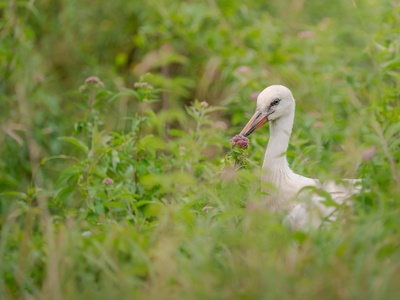
White Stork
A familiar large white bird with black flight feathers and a red bill and legs. Arrives in Namibia in large numbers during the European winter. It forages in open grasslands and wetlands for insects, particularly locusts, making it beneficial to farmers.

Hadeda Ibis
A large, noisy ibis known for its loud, penetrating “ha-ha-ha-de-dah” call, especially in the early morning. It has grey-brown plumage with an iridescent purple-green sheen on its wings. It probes lawns and soil for insects and earthworms.
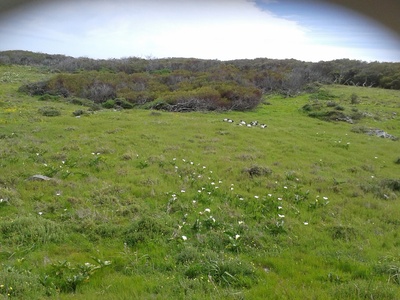
African Sacred Ibis
A striking ibis with an all-white body, a bare black head and neck, and a long, decurved black bill. Historically revered in ancient Egypt, it is now a common sight in wetlands and even urban areas, where it scavenges for a wide variety of food.

Glossy Ibis
A medium-sized ibis that appears black from a distance but reveals a stunning iridescence of bronze, green, and purple in good light. It typically forages in flocks, probing in mud and shallow water for invertebrates.

African Spoonbill
An unmistakable large white bird with a long, flattened, spoon-shaped bill. It feeds by wading through shallow water and sweeping its partially open bill from side to side, sifting out small fish, crustaceans, and insects from the water.

Greater Flamingo
The larger and paler of the two flamingo species in Namibia. It has subtle pink plumage with bright red wing coverts visible in flight. It feeds by holding its large, bent bill upside down in the water to filter out small invertebrates.

Lesser Flamingo
Smaller and much more vibrantly pink than the Greater Flamingo, with a dark red bill. They occur in vast numbers, especially at coastal lagoons, where their specialised bill is perfectly adapted for filtering microscopic blue-green algae from the water.

Egyptian Goose
A noisy and aggressive goose, often seen in pairs or family groups. It has pale brown and grey plumage with a distinctive dark brown eye patch and a chestnut patch on its breast. Despite its name, it is technically a shelduck, not a true goose.
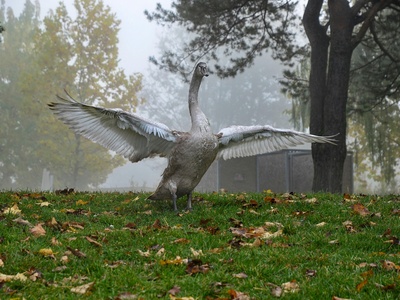
Spur-winged Goose
Africa’s largest waterfowl, this massive “goose” has mostly black plumage with a white face and belly. It is named for the sharp spur hidden on the bend of its wing, which is used in territorial fights. It grazes on grasses and aquatic plants.
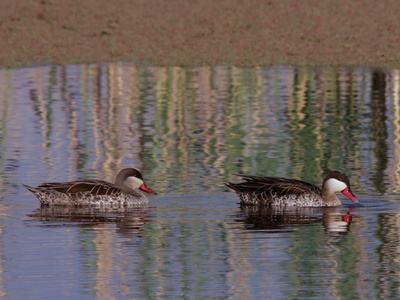
Cape Teal
A small, pale, mottled duck with a distinctive pink bill and red eye. It is well adapted to saline and brackish waters where it dabbles for aquatic invertebrates and seeds. Often seen in pairs or small groups on open, shallow pans.

Red-billed Teal
A handsome duck with a dark cap, pale cheeks, and a striking bright red bill. It is one of the most common and widespread ducks in Namibia, often gathering in large flocks on freshwater pans and dams, where it dabbles for seeds and invertebrates.
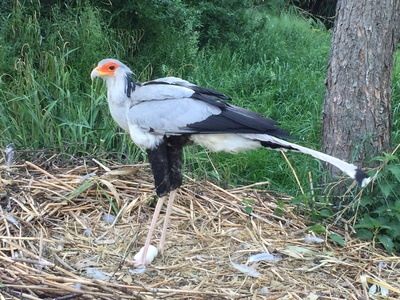
Secretarybird
A large, terrestrial bird of prey that looks like a cross between an eagle and a crane. Famous for its long legs and crest of black feathers resembling quill pens. It hunts on foot, stomping on snakes and other reptiles to kill them.

African Fish Eagle
Possesses one of Africa’s most evocative calls, often described as the “voice of Africa.” This large, magnificent eagle has a pure white head and breast, a rich chestnut belly, and black wings. It snatches fish from the water’s surface with its talons.

Bateleur
A spectacular and colourful eagle known for its unique acrobatic, rocking flight style. Adults have a black body, grey shoulders, a chestnut back, and a bright red face and legs. It has a remarkably short tail, which enhances its aerial agility.

Lappet-faced Vulture
The largest and most powerful of Africa’s vultures. Its massive bill can tear through tough hides that other vultures cannot. It has a bare, pinkish-red head with distinctive folds of skin (lappets). Often dominates other species at a carcass.

White-backed Vulture
The most common vulture in Namibia, though critically endangered. It is a classic “gyps” vulture, with a scruffy appearance, a bald neck, and a contrasting white rump that is conspicuous in flight. It is a social scavenger, often gathering in large numbers at carcasses.
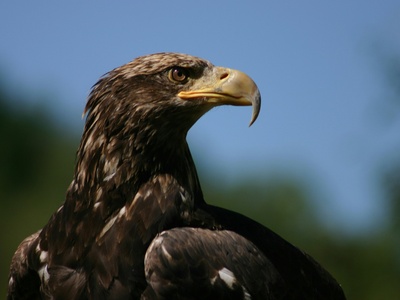
Martial Eagle
Africa’s largest eagle, a powerful and impressive apex predator. It has dark upperparts, a white belly with sparse black spots, and a prominent crest. It preys on a wide range of animals, from gamebirds and monitor lizards to small antelopes.
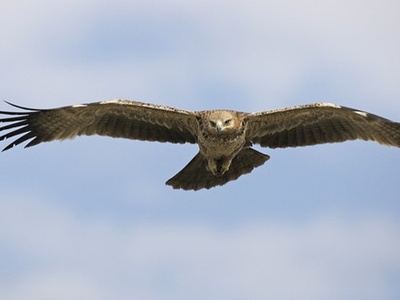
Tawny Eagle
A large, robust eagle with highly variable brownish plumage, ranging from pale tawny to dark brown. It is a highly opportunistic predator and scavenger, often stealing kills from other raptors or feeding on carcasses, as well as hunting live prey.
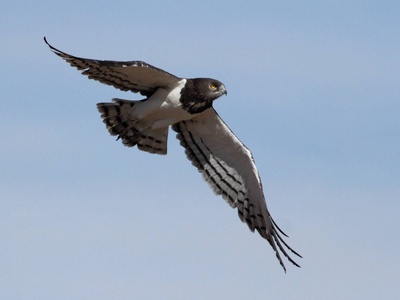
Black-chested Snake Eagle
A large, striking snake eagle with a dark black head and chest that contrasts sharply with its white belly. It has large, piercing yellow eyes. It hunts by hovering or soaring high above the ground before dropping down to catch snakes and lizards.
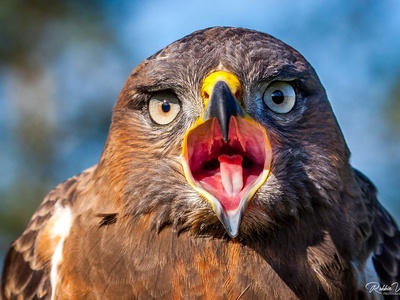
Jackal Buzzard
A stocky, powerful raptor named for its jackal-like yelping call. Adults are mostly black with a rich rufous chest and tail, and a white throat. Often seen perched on telephone poles or soaring over rocky hillsides in search of small mammals.
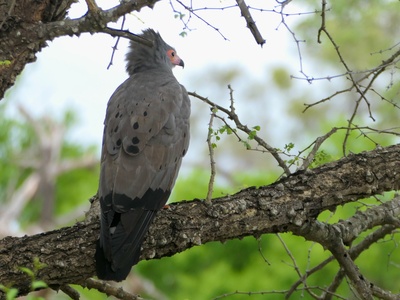
African Harrier-Hawk
A unique, lanky raptor with long, double-jointed legs that allow it to probe into holes and crevices for lizards, eggs, and nestlings. It has a grey body, barred belly, and a bare patch of facial skin that flushes red when excited.
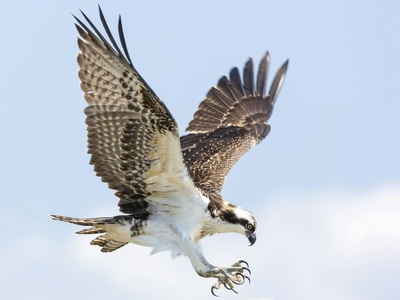
Osprey
A specialised fish-eating raptor found worldwide. It has a white head with a dark stripe through the eye. It hunts by hovering over water before plunging feet-first to grab fish with its sharp talons, which have spiny pads for a secure grip.

Black-shouldered Kite
A small, elegant raptor with pale grey and white plumage, black shoulder patches, and striking red eyes. It is famous for its ability to hover motionless in the wind like a kestrel while scanning the ground for rodents and insects.

Peregrine Falcon
Renowned as the fastest animal on the planet, reaching incredible speeds during its hunting stoop. It is a powerful, crow-sized falcon with a dark “helmet” and “moustache,” preying almost exclusively on other birds caught in mid-air.

Lanner Falcon
A large, powerful falcon with a rufous crown and nape. It is a versatile hunter, catching birds in the air or pursuing prey on the ground. Often seen in pairs, they can hunt cooperatively to flush and catch their quarry.
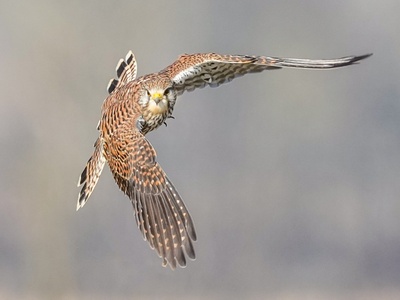
Rock Kestrel
A familiar small falcon, often seen perched on telephone wires or hovering over grassy slopes. It has warm rufous-brown plumage with black spots. It is a highly adaptable hunter, preying on insects, lizards, and small rodents.
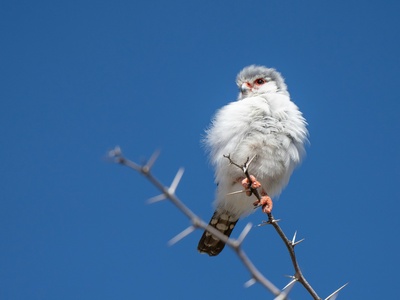
Pygmy Falcon
Africa’s smallest raptor, this tiny falcon is barely larger than a sparrow. It has a grey back and white underparts, with females showing a chestnut back. It has a close relationship with Sociable Weavers, often roosting and nesting in their huge communal nests.

Helmeted Guineafowl
A distinctive and noisy bird, often seen in large flocks foraging on the ground. It has a plump, dark grey body covered in white spots, and a bare blue and red head topped with a bony “helmet” or casque. They roost in trees at night for safety.

Hartlaub’s Spurfowl
A small, secretive spurfowl endemic to Namibia and Angola. It has cryptic brown and grey plumage, with a distinctive white eyebrow and red legs. Its loud, ringing duet is often the best way to locate this shy bird among the rocky outcrops it calls home.
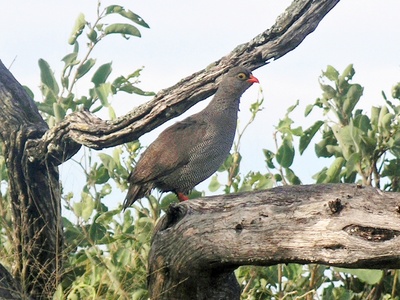
Red-billed Spurfowl
A medium-sized, grey-brown spurfowl with fine barring on its underparts. It is easily identified by its bright red bill and bare yellow skin around the eye. Often seen foraging in pairs or small family groups along roadsides in the early morning.

Kori Bustard
One of the world’s heaviest flying birds. Males are huge and perform impressive courtship displays, inflating their neck pouches like a giant white balloon. They are slow, deliberate walkers, foraging for insects, seeds, and small reptiles on the ground.
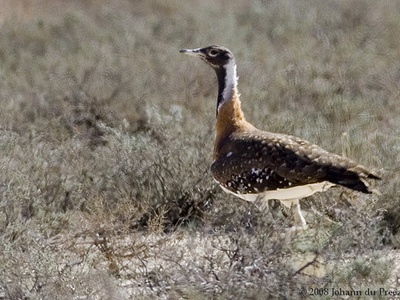
Ludwig’s Bustard
A large, stately bustard that undertakes nomadic movements in response to rainfall. It has a brown back, white belly, and a striking black-and-white neck pattern. It is vulnerable to collisions with power lines, a major threat to its population.

Rüppell’s Korhaan
A slender, cryptically coloured korhaan perfectly adapted to the desert. It has a striking black-and-white head and neck pattern. Males have a distinctive call, a series of accelerating clicks, which they deliver while throwing their heads back.
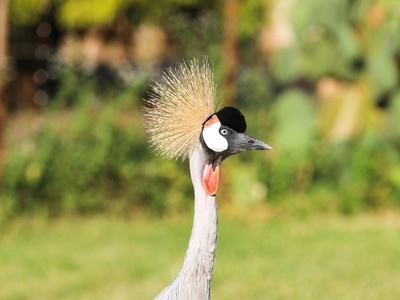
Grey Crowned Crane
An elegant and beautiful bird, easily recognised by the stiff, golden crown of feathers on its head. It has a grey body with white wings. Unlike other cranes, it can roost in trees, thanks to a long hind toe that allows it to grip branches.
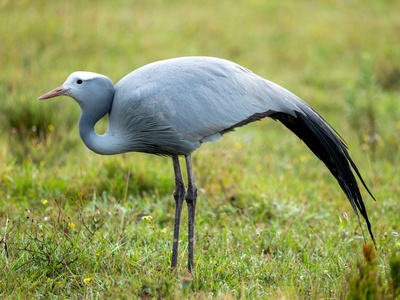
Blue Crane
South Africa’s national bird, with a small, vulnerable population in Namibia. It is a graceful, uniform blue-grey crane with long, dark wing feathers that trail behind it like a train. It performs a spectacular dancing display during courtship.
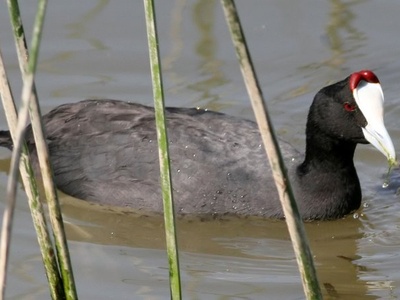
Red-knobbed Coot
A plump, dark slate-grey waterbird with a distinctive white bill and frontal shield. During breeding season, it develops two prominent red knobs on top of the shield, which give it its name. It is often seen grazing on aquatic plants.
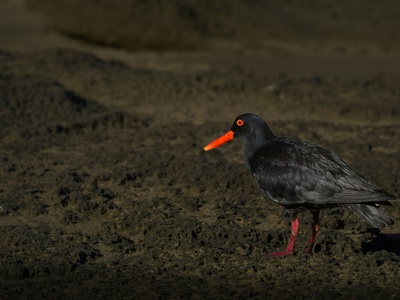
African Oystercatcher
A striking, all-black shorebird with a long, bright red bill, red legs, and a red eye-ring. It is a specialist feeder, using its strong, flattened bill to pry open mussels and limpets or probe for worms in the sand.
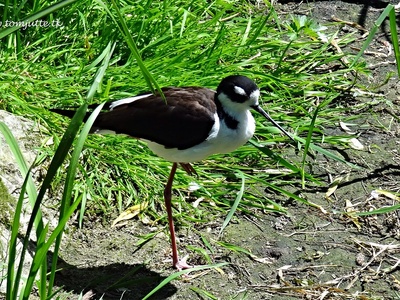
Black-winged Stilt
An elegant and unmistakable wader with black and white plumage, a fine black bill, and ridiculously long, thin, pinkish-red legs. It wades through shallow water, picking insects and small crustaceans from the surface or mud.
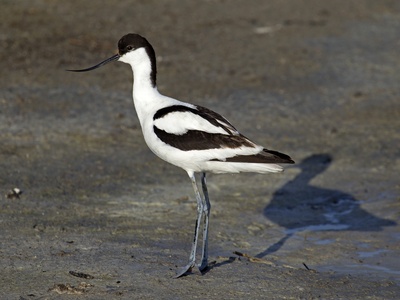
Pied Avocet
A graceful wader with striking black-and-white plumage and a unique, long, slender, upcurved bill. It feeds by sweeping its bill from side to side through shallow water or soft mud to detect and catch small aquatic invertebrates.
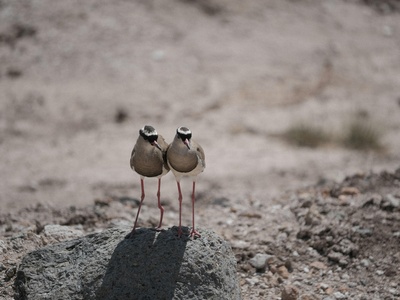
Crowned Lapwing
A noisy and conspicuous plover, often found in pairs or small groups. It has a brown back, white belly, and a distinctive black crown circled by a white “halo” or crown. It is known for its loud, persistent “kie-riet” alarm call.
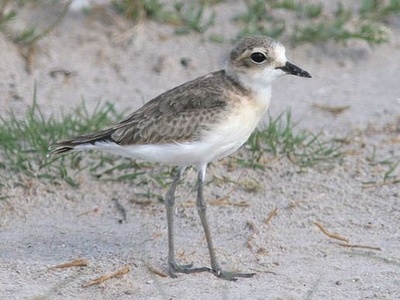
Kittlitz’s Plover
A small, pale, sandy-brown plover often seen running in short bursts across open ground. It has a distinctive white forehead and supercilium. It has a unique habit of kicking sand over its eggs to conceal them from predators when leaving the nest.
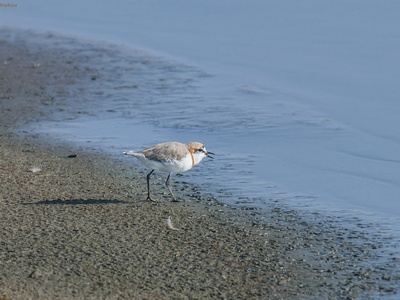
Chestnut-banded Plover
A tiny, pale plover with a thin chestnut breast-band (brighter in males). It is highly dependent on saline wetlands and is a key indicator species for the health of these habitats. Its delicate appearance belies its hardy nature.

Damara Tern
A small, graceful, and near-threatened tern that breeds only in Namibia and South Africa. It has pale grey plumage and a black cap. It nests in shallow scrapes on gravel plains, making its nests highly vulnerable to human disturbance.

Kelp Gull
The most common and familiar large gull along Namibia’s coast. Adults have a white head and body, a black back and wings, and a powerful yellow bill with a red spot. It is an opportunistic scavenger and predator, found everywhere from beaches to landfill sites.
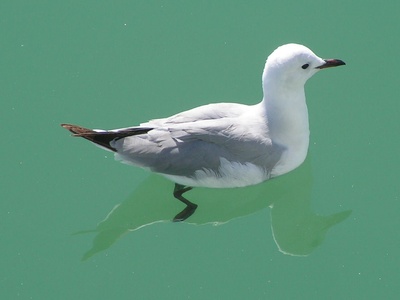
Hartlaub’s Gull
A small, elegant gull with a pale grey back, white head, and a slender, dark red bill. It is much more delicate than the larger Kelp Gull and is a common sight in coastal towns, harbours, and lagoons, often scavenging for scraps.
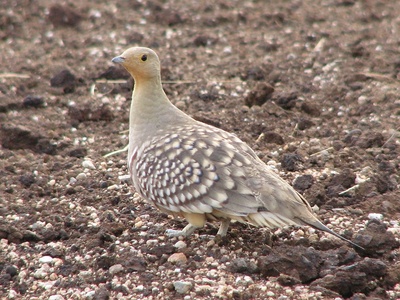
Namaqua Sandgrouse
A pigeon-like bird of arid regions, known for its incredible daily flights to waterholes. Males have a striking yellow-orange face and a black-and-white breast-band. The male’s belly feathers are specially adapted to absorb and carry water back to the chicks.

Speckled Pigeon
A large, robust pigeon with grey plumage, speckled white spots on its wings, and a distinctive patch of bare, red skin around the eye. It has adapted well to urban environments, often nesting on buildings and other man-made structures.
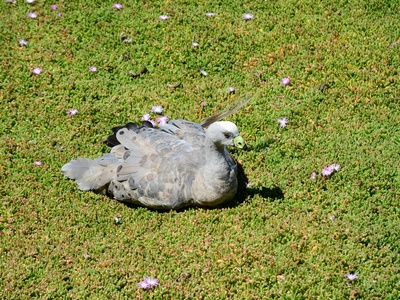
Cape Turtle Dove
One of Namibia’s most common and widespread birds. It is a slender, pale grey dove with a distinctive black half-collar on its hindneck. Its monotonous, three-syllable call, “kuk-coo-koo,” is a familiar sound throughout the country.
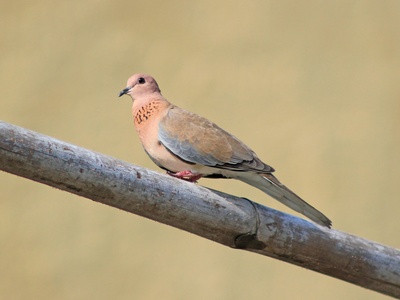
Laughing Dove
A small, slim dove with a pinkish head and breast, and a rufous back. It is named for its gentle, bubbling, rising-and-falling cooing, which sounds like soft laughter. Often seen foraging for seeds on the ground in gardens and parks.
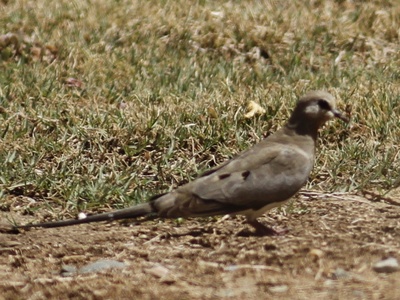
Namaqua Dove
A small, slender dove with a remarkably long, tapering black tail. The male is striking, with a black face, throat, and breast. It is often seen on the ground in arid areas, where its fast, direct flight is distinctive.

Rosy-faced Lovebird
A small, colourful, and noisy parrot with a bright green body, a rosy-pink face and throat, and a blue rump. They are highly social, often seen in screeching flocks. They nest in rock crevices or take over chambers in Sociable Weaver nests.
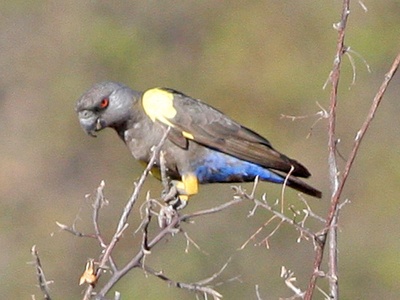
Rüppell’s Parrot
A medium-sized, brownish-grey parrot with distinctive yellow patches on its shoulders and “thighs.” Females have a blue rump. It is a quiet and unobtrusive parrot, usually found in pairs or small groups feeding on seeds and fruits.

Grey Go-away-bird
A large, long-tailed, plain grey bird with a prominent crest that it raises and lowers. Its name comes from its nasal, drawn-out “g’wa-a-a-y” call, which is said to warn other animals of danger. Feeds mainly on fruits, leaves, and flowers.

Spotted Eagle-Owl
A medium-sized owl with prominent ear-tufts, mottled grey-brown plumage, and large, piercing yellow eyes. It is a highly adaptable nocturnal hunter, preying on insects, rodents, and small birds. Its hooting duet is a common sound at night.
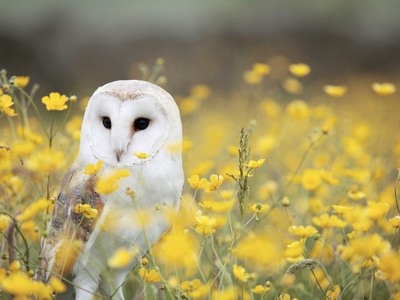
Barn Owl
A distinctive, medium-sized owl with a heart-shaped, white facial disc, a mottled golden-brown back, and pure white underparts. It is a silent nocturnal hunter, preying primarily on rodents, making it a valuable ally to farmers. Roosts in barns, buildings, and tree holes.
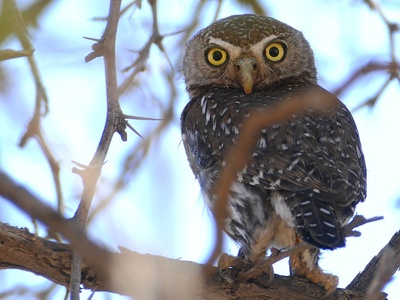
Pearl-spotted Owlet
A tiny, diurnal owl with a long, barred tail and a “false face” of two black eye-spots on the back of its head to deter predators. It has a distinctive call, a series of rising, whistling notes that accelerate into a crescendo.
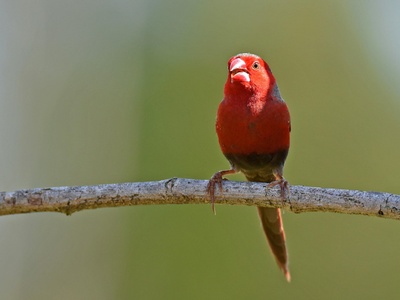
Red-faced Mousebird
A slender, greyish-brown bird with a long, stiff tail, a prominent crest, and a bright red face and bill. Highly social, they are often seen in small groups, scrambling through foliage like mice, which gives them their name.
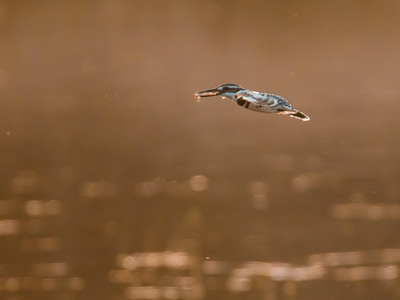
Pied Kingfisher
A striking black-and-white kingfisher, often seen hovering expertly over water before plunging down to catch small fish. It is highly social and often nests in colonies in riverbanks. Males have a double breast-band, while females have a single, broken one.
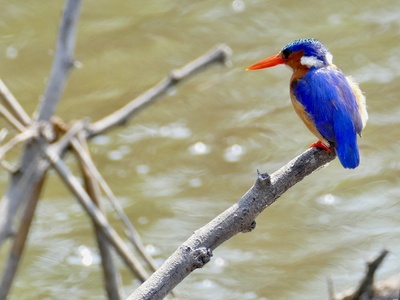
Malachite Kingfisher
A tiny, brilliantly coloured kingfisher with iridescent blue upperparts, a rufous belly, and a short, bright blue crest. It perches on reeds overhanging water, diving in a flash of blue to catch tiny fish and aquatic insects.
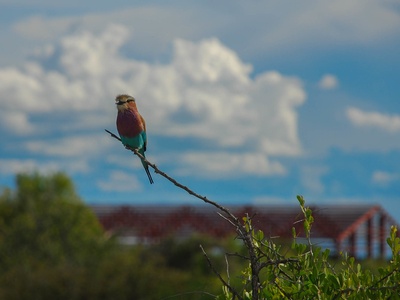
Lilac-breasted Roller
An spectacularly colourful bird, often seen perched on a dead tree or telephone wire. It has a lilac throat, a blue belly, and a green head. When it flies, it reveals brilliant blue wings and performs an acrobatic rolling display.

African Hoopoe
An unmistakable bird with sandy-pink plumage, bold black-and-white barred wings and tail, and a large, fan-like crest that it raises when excited. It forages on the ground, probing the soil with its long, decurved bill for insects and larvae.

Southern Yellow-billed Hornbill
A characterful black-and-white hornbill with a massive, down-curved yellow bill. It is often seen foraging on the ground for insects, seeds, and small reptiles. It is the inspiration for the character Zazu in Disney’s “The Lion King”.

Monteiro’s Hornbill
A large, brown-and-white hornbill with a massive reddish-orange bill. Endemic to the dry, rocky hillsides of north-western Namibia and Angola. It is well-adapted to arid conditions, obtaining much of its moisture from the food it eats.

Damara Hornbill
Very similar to the Southern Yellow-billed Hornbill, but with a darker bill, less white on the wings, and flesh-coloured facial skin. Its status as a full species is debated, but it represents a unique form found primarily in north-central Namibia.

Acacia Pied Barbet
A small, striking black-and-white bird with a red forehead, a yellow eye-stripe, and a thick, stout bill. It has a distinctive, monotonous call, a loud “pop-pop-pop” that can continue for long periods. Excavates its nest in dead tree branches.

Sociable Weaver
A small, plain-looking bird famous for building the largest and most spectacular communal nests of any bird in the world. These massive thatched structures, often built on telephone poles or quiver trees, can house hundreds of birds for generations.

